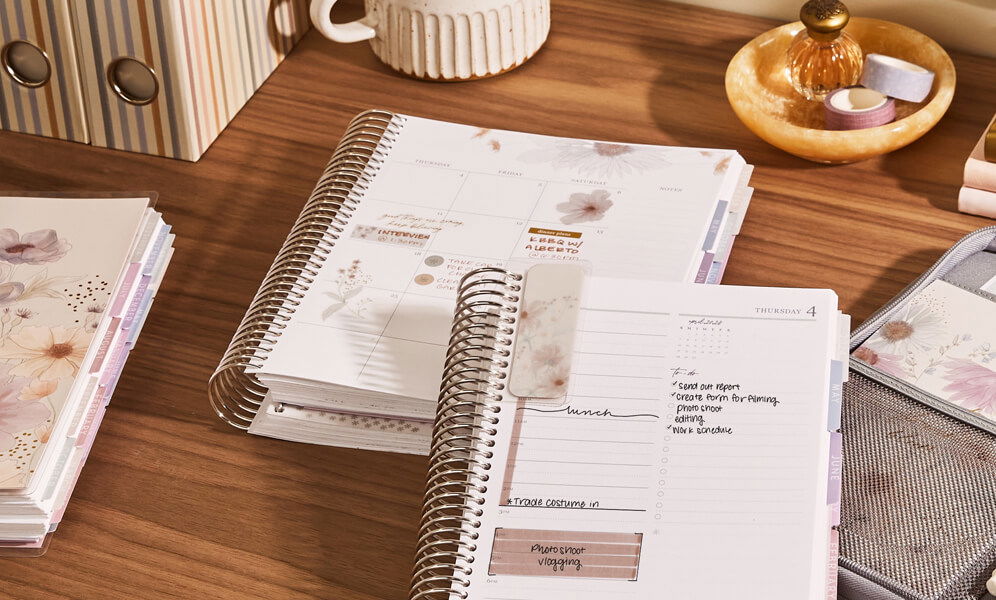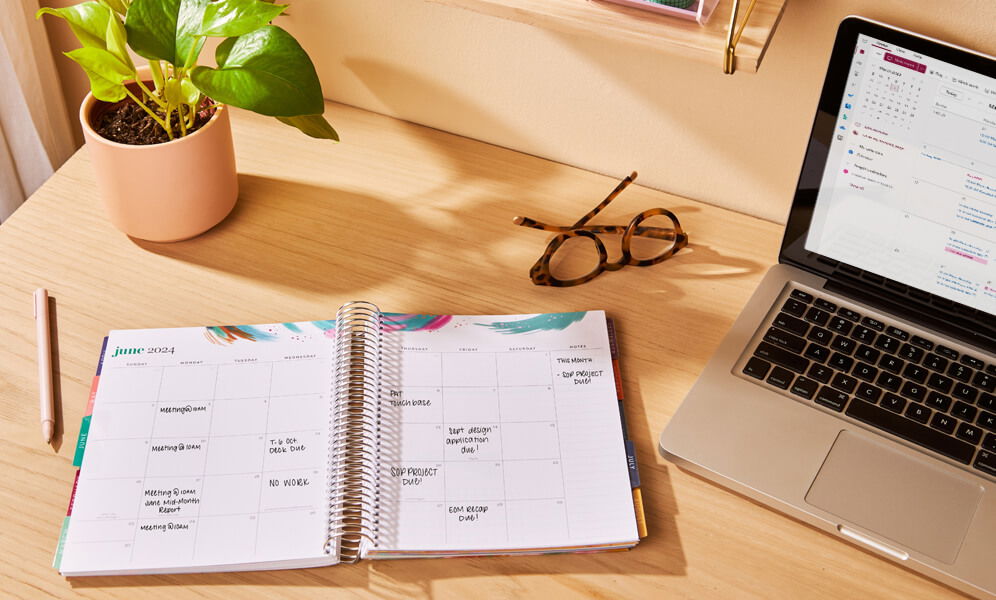How to Use Multiple Planners for More Personalized Planning

Planning plays a crucial role in our lives, helping us stay organized and achieve our goals. While a single planner can be effective, sometimes one size doesn't fit all. That's where the concept of using multiple planners comes in. By combining different planners (also called organizers, agendas, and calendar organizers) for specific purposes, such as bullet journals, daily planners, or weekly planners, you can create a personalized planning system that suits your unique needs and preferences. In this article, we'll explore why using multiple calendar organizers can be beneficial and provide practical tips on how to effectively utilize them.
Why Use Multiple Planners?
Using multiple organizers or journals offers several benefits for organizing your work, personal life, and years ahead:
- Tailored Functionality: Different types of planners, such as bullet journals or daily planners, are designed to serve specific purposes. By using multiple planners, you can take advantage of their individual features and functionalities. For example, a bullet journal allows for creative freedom and flexible page layouts, while a daily planner provides a structured framework for organizing your tasks.
- Enhanced Focus and Space: Each planner provides a designated space for specific tasks, goals, or areas of your life. By separating different aspects of your life into separate planners, such as work, personal life, or meal planning, you can maintain better focus and avoid the clutter of having everything in one place. This separation also provides ample space to brainstorm ideas, track progress, and jot down a daily to-do list.
- Customization and Personalization: Multiple calendar organizers offer the flexibility to customize and personalize your planning experience. Whether you prefer digital planners or paper-based journals, you can choose the types of planners that align with your preferences and organizational style. This customization helps create a planning system that reflects your personality and optimizes your productivity.
How to Use Multiple Planners
Now that we understand the benefits of using multiple planners, let's explore how to effectively integrate them into your planning routine.
Choosing Planners That Work Well Together

When selecting multiple organizers or journals, consider the following factors to ensure they work harmoniously:
- Consistent Layout: Opt for planners or journals with similar layouts or formats. This consistency allows for seamless transitions between organizers and maintains a cohesive planning system. For example, if you prefer a weekly layout in one planner, choose similar layouts in others to maintain consistency across your planning routine.
- Compatibility: If you use both digital and paper planners, ensure they are compatible and allow for easy synchronization. Digital planners offer the advantage of syncing across devices, while paper planners provide a tactile experience. Explore digital planners that allow importing and exporting data, ensuring that your digital planners and paper planners stay in sync.
- Personal Preferences: Choose planners or journals that resonate with your personal style and preferences. Whether you opt for bullet journals, daily planners, or weekly planners, consider factors such as design, color scheme, and additional features that align with your aesthetic and functional preferences. Personalizing your planners enhances your motivation and enjoyment of the planning process.
Learn more about how to choose the right planner. Check out 11 Different Planner Types Explained + How to Choose.
Setting Up and Customizing Your Planners
To maximize the effectiveness of your multiple planners, consider the following steps:
- Assign Each Planner a Purpose: Clearly define the purpose and scope of each planner. Determine what kind of information will be stored in each one. For example, you can allocate a separate planner for work-related tasks, personal goals, meal planning, or creative projects. This ensures that each planner has a specific focus and helps you stay organized.
- Customize Layouts and Pages: Tailor the layout and pages of each planner to suit your specific needs. Add sections for tasks and to-do lists, events, goals, notes, or any other relevant categories. Utilize page numbers, dividers, and tabs to organize your planners efficiently. Customizing the layouts and pages ensures that each planner optimizes your planning process and accommodates your unique requirements.
- Utilize Tools and Techniques: Explore various planning tools and techniques, such as habit trackers, goal setting frameworks, or time management strategies, to enhance your planning experience. For example, you can include a habit tracker in your daily planner to monitor progress on daily tasks or incorporate time-blocking techniques in your weekly planner to allocate dedicated time slots for different activities.
Planning and Tracking Tasks, Events, and Goals Across Multiple Planners
Effectively managing tasks, events, and goals across multiple planners requires coordination and synchronization. Follow these tips to streamline your planning process:
- Consistent Review: Regularly review and update all your planners to ensure they remain up to date. Dedicate specific times each week or month to consolidate information and make necessary adjustments. This consistent review allows you to stay on top of your commitments and track your progress effectively.
- Cross-Referencing: Whenever you enter a new task or event in one planner, make it a habit to cross-reference it in the relevant planners or journals. This ensures that all pertinent information is captured across your planning system. For example, if you schedule a meeting in your work planner, make sure to include it in your digital calendar or personal planner to avoid conflicts.
- Establishing Connections: Identify connections and dependencies between different areas of your life or projects. Link relevant information between planners or journals to maintain a holistic view of your commitments and progress. For instance, if a personal goal requires time allocated in your daily planner, ensure that it is reflected in your weekly or monthly planner as well.
For more planning tips, explore How to Start Planning.
How to Stay Organized When Using Multiple Planners
While using multiple planners or journals offers numerous benefits, it's important to stay organized and avoid becoming overwhelmed. Here are some strategies to help you stay on track:
Syncing Information in Multiple Planners
If you use both digital planners and paper planners, syncing information between them is crucial for seamless planning:
- Digital Integration: Explore digital planning tools or apps that offer synchronization across multiple devices. This allows you to access and update your planners digitally, ensuring information consistency. Utilize digital planners that support importing and exporting data, enabling synchronization with your paper-based planners.
- Regular Updates: Make it a habit to update both your digital and paper-based planners regularly. Set reminders or allocate specific times to transfer information between the two. Consistency in updating ensures that both versions of your planners stay synchronized and accurate.
Prioritizing Tasks and Allocating Time When Using Multiple Planners
To avoid feeling overwhelmed, prioritize tasks and allocate time effectively across your multiple planners or journals:
- Identify Key Priorities: Determine the most important tasks and goals across all your planners or journals. Focus on these priorities to avoid spreading yourself too thin. Use techniques like Eisenhower's Matrix or ABC analysis to categorize tasks based on importance and urgency.
- Time Blocking: Allocate dedicated time slots for different areas of your life in your daily or weekly planners or journals. This technique helps ensure that you devote sufficient time to each aspect and prevents overcommitment. By blocking specific time periods for work, personal activities, and self-care, you create a structured schedule that helps you stay focused and productive.
Reviewing and Updating Your Planners
Regularly reviewing and updating your planners or journals is essential to maintain their effectiveness:
- Weekly Reviews: Set aside time each week to review the past week's progress, plan for the upcoming week, and make adjustments to your planners or journals. Reflect on your achievements, identify areas for improvement, and update your tasks and goals accordingly.
- Monthly Reflections: Conduct monthly reflections to assess your overall progress, reevaluate goals, and make any necessary changes to your planning system. Use this time to celebrate milestones, analyze your productivity, and refine your approach to planning. This reflection helps you stay aligned with your long-term objectives and make adjustments as needed.
Avoiding Overload and Burnout with Multiple Planners
Using multiple planners or journals can be a great way to stay organized and on track. However, it's important to avoid feeling overwhelmed.
Consider the original LifePlanner™ collection – the ultimate everything planner that combines the best features of a calendar, to-do list, and journal in one! It pairs well with any specialty planner – from Teacher Lesson Planners and Academic Planners to Productivity Planners, and more!
Here are a couple of tips for using multiple planners effectively:
- Start small. Begin by incorporating one or two additional planners or journals into your routine. Gradually expand your system as you become comfortable managing multiple planners.
- Simplify and streamline. Regularly reassess your planning system and eliminate any redundancies or unnecessary complexities. Keep your planners or journals focused on what truly matters to you. Simplify your processes and streamline your planning routine to ensure efficiency and clarity.
By effectively utilizing multiple planners or journals, you can create a personalized planning system that empowers you to stay organized, focused, and motivated.
Start by exploring the Best Planners for every purpose and every stage of planning, and build your custom planner to fit your schedule and style!
Frequently Asked Questions
The key to using multiple planners effectively is to establish a clear purpose for each planner and create a routine for maintaining them. Start by designating a "home base" planner (like a life planner) for your main schedule and daily tasks. Then, add specialized planners for specific areas of your life, such as a fitness planner or work-life balance journal. Set aside 15 minutes each morning to review your planners and 10 minutes each evening to update them. Create a simple color-coding system to cross-reference events and tasks between planners, and always keep your most frequently used planners together in a designated planning space. Remember, effective planning is about finding what works for you—don't feel pressured to use every page of every planner!
Our top tips for success with multiple planners focus on creating a sustainable system that works for your lifestyle. First, develop a consistent "planning power hour" each Sunday to sync all your planners for the week ahead. Second, use sticky notes for tasks that might need to move between planners instead of writing them directly on pages. Third, keep a primary index in your primary planner that tells you where to find specific information in your other planners. Fourth, use matching accessories like our snap-in bookmarks across all your planners to maintain consistent categorization. Finally, implement the "two-minute rule"—if updating a planner will take less than two minutes, do it immediately rather than putting it off. These strategies help maintain organization without letting multiple planners become overwhelming.
Different areas of life benefit from different planner types designed to support specific goals and activities. For work, a daily planner or weekly planner helps manage projects, meetings, and deadlines with hourly scheduling. Teachers love using a dedicated lesson planner for curriculum planning and classroom organization. For wellness, use a wellness planner to tracks habits, meals, and exercise routines. Those who are budget-conscious benefit from a dedicated budget planner for expense tracking and financial goal-setting. Creative projects flourish with a custom notebook or journal, perfect for brainstorming and project planning. Family life stays organized with a monthly planner or family organizer book, great for coordinating schedules and planning activities. Students stay on track with an academic planner, designed for assignment tracking and study planning. Each planner type offers unique features tailored to its specific purpose so you can plan each area of your life, your way.

